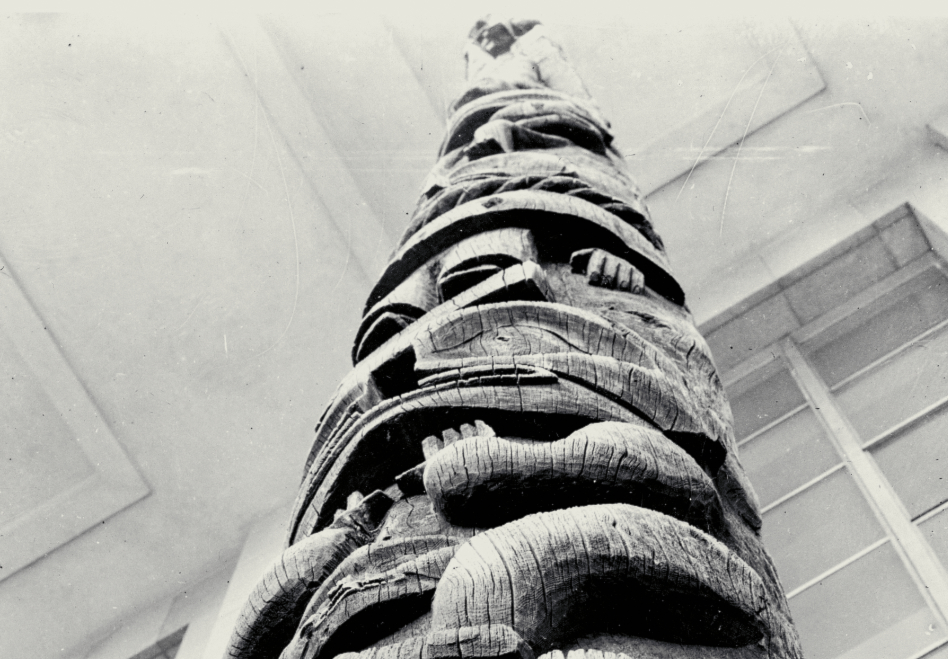A delegation of Witsuwit’en hereditary chiefs, elders, artists and youth from C’inegh Lhay Yikh (House of Many Eyes) of the Likhsilyu Clan (Small Frog) travelled to Paris, France in the third week of October, 2024 in search of their history and its connection to the Quai Branly – Jacques Chirac Museum.
In 1938, Kurt Seligmann, a surrealist artist interested in Northwest Coast Indigenous art, came to British Columbia to purchase a totem pole. After corresponding with anthropologist Marius Barbeau, who had studied the region’s totem poles, he decided on the K’ëgit pole. It was considered one of the oldest and most skilfully carved, left standing in the Witsuwit’en village of Tsë Cakh (Hagwilget). The pole, which retells the story of K’ëgit a supernatural creature, was raised by former C’inegh Lhay Yikh house chief C’idimsggin’ïs in the early to mid-1800s.
With the Department of Indian Affairs and the local Indian Agent’s support, Likhsilyu House Chief Hagwilnekhlh Arthur Michell and relatives Gwinu Little Dennis, Simah Sam Jimmy Michell, Guts’ilik Joe Nass and Ggaclh Phillip Austin were pressured to sell the pole for a mere $100. After being repaired due to damage done during its removal, the K’ëgit pole was sent by train to Vancouver and then Paris, France by boat. In early 1939, after extensive restoration, it was displayed in front of the Musée de l’homme (Museum of Man) in Paris until 2001, when it was transferred to the Quai Branly Museum, where it underwent a second restoration process.

Hagwilnekhlh Ron Mitchell, C’inegh Lhay Yikh’s current House Chief, has mixed emotions about visiting the museum: “It’s quite emotional when I think about our people. I will be happy to see the totem pole and a part of our house and chief’s history, but sad at the same time. I am curious about the carver. I’m sure my grand-mother ’Ilhdesinon Josephine Michell (Arthur Michell’s daughter) knew who the carver was. It is an original Witsuwit’en pole in terms of its style, not so Northwest Coast…and I really like that. I was disheartened when I heard that they took it apart to move it. They should never have done that without understanding what it means to our people. Back then, they were strict about ’anuc niwh’it’ën (our laws) and when a pole fell they didn’t move it.”
For another delegation member, SD54 District Principal of Indigenous Education ’Ilhdesinon Birdy Markert, the totem pole’s history is personal and profound: “It’s an emotional uncovering of past stories regarding our traditions that are difficult to pull apart, but also my great-grandfather Arthur Michell’s experience of the pole’s removal. Poles were never removed; they fell and returned to nature. Why does he seem to have been alone in dealing with this? Why were his wife and children not involved? It’s such a clash of cultures. He had already been jailed several times for fighting for his land; he must have felt helpless. I want young people to understand what our ancestors went through as they dealt with colonisation and how hard they fought to keep our culture and traditions alive. This trip is a powerful opportunity for exchange and reclamation.”
Master Carver Dzïggot Ron Austin has dreamt of seeing the K’ëgit pole for years: “It’s an amazing opportunity to see the pole that may have belonged to my grand-mother’s older brother, C’idimsggin’ïs. It means a lot as an artist to see what my ancestors created before me in person. K’ëgit had a long, hooked nose like sggïgit (eagle), which is where the name came from. I think it will be inspirational. It might inspire me in a different direction in my style.” Ts’akë ze’ West’es Sandra Martin Harris explains, “Our stories shared on ts’an (totem poles) are such an integral part of our crests, names, identity and connection to the yin tah in our Clans, House Groups and villages. We did not get to witness its life force, while it stood firmly on the land for all to witness. We didn’t get to artistically share the story of the supernatural being, K’ëgit, the way our ancestors did through the beautiful carvings on the K’ëgit pole. I am grateful to be able to visit our relative and to be together with Dinï ze’ and Ts’akë ze’ and youth on this painful rematriation journey.”
The delegation’s goal is to restore and revitalise the Witsuwit’en’s cultural connection to the K’ëgit pole and inspire ongoing cultural revitalisation efforts and healing for clans and community.
The visit to the Quai Branly Museum to see the K’ëgit totem pole is the result of collaboration between the Likhsilyu Clan, Kyah Wiget Education Society, Florida State University, York University, the Bulkley Valley Museum and School District 54 (Bulkley Valley). Funding and
financial support has been provided by the Wetzin'kwa Community Forest Corporation, the British Columbia Network Environment for Indigenous Health Research, School District 54 (Bulkley Valley) and the Bulkley Valley Community Foundation.
For more information contact: Birdy Markert at birdy@sd54.bc.ca
Photo caption: View of the K’ëgit totem pole in 1956 at the Musée de l’homme in Paris, France
Photo credit: J3882 Marius Barbeau, Museum of History
